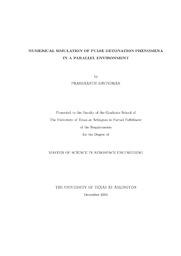| dc.contributor.author | Ravindran, Prashaanth | en_US |
| dc.date.accessioned | 2007-08-23T01:56:29Z | |
| dc.date.available | 2007-08-23T01:56:29Z | |
| dc.date.issued | 2007-08-23T01:56:29Z | |
| dc.date.submitted | August 2005 | en_US |
| dc.identifier.other | DISS-1096 | en_US |
| dc.identifier.uri | http://hdl.handle.net/10106/329 | |
| dc.description.abstract | The objective of this work was to develop a parallel algorithm that would be used in the simulation of the detonation process in the chamber of a pulse detonation engine. The emphasis is laid on reducing computation time while maintaining the accuracy of the solution and subsequently developing a numerical solution to be in agreement with real-world physical characteristics of a detonation wave initiation, build-up and progression. The flow is assumed to be unsteady, inviscid and non heat conducting. To adhere to real time effects, the flow equations are coupled with finite rate chemistry and the vibrational energy equation are based on a two-temperature model, to account for possible vibrational non-equilibrium. Finite Volume formulation is employed to ensure conservation and to allow proper handling of discontinuities. Runge-Kutta integration scheme has been utilized to obtain a time-accurate solution, with Roe's flux difference splitting scheme applied to cell face fluxes. For higher-order spatial accuracy, MUSCL technique is employed. Equation stiffness has been taken care of by observing point implicit treatment of the source terms and detonation is initiated with the application of a localized hot-spot. The parallel algorithm has been developed using Message Passing Interface standard developed by the Argonne National Laboratory for the purposes of solving equations in a distributed environment. A Proto-cluster of Beowulf type consisting of 8-nodes has been assembled and made operational, and an algorithm which performs space-time calculations simultaneously on the nodes has beensuccessfully developed.A two-step global model for Hydrogen-Air mixture has been selected for validating the parallel algorithm with existing results, to establish veracity and accuracy while reducing computation time to almost a fourth. Excellent agreement has been found on comparison of the results with the same code when solved in a single processor. | en_US |
| dc.description.sponsorship | Lu, Frank | en_US |
| dc.language.iso | EN | en_US |
| dc.publisher | Aerospace Engineering | en_US |
| dc.title | Numerical Simulation Of Pulse Detonation Phenomena In A Parallel Environment | en_US |
| dc.type | M.S. | en_US |
| dc.contributor.committeeChair | Lu, Frank | en_US |
| dc.degree.department | Aerospace Engineering | en_US |
| dc.degree.discipline | Aerospace Engineering | en_US |
| dc.degree.grantor | University of Texas at Arlington | en_US |
| dc.degree.level | masters | en_US |
| dc.degree.name | M.S. | en_US |
| dc.identifier.externalLink | https://www.uta.edu/ra/real/editprofile.php?onlyview=1&pid=274 | |
| dc.identifier.externalLinkDescription | Link to Research Profiles | |

